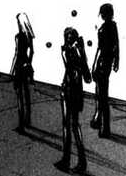|
MonsterEnvy posted:Don't make it a spell that only the Orc can cast, instead make it an ability that only the Orc can use. Wizards and warlocks and clerics and druids and rangers all have spells they can't learn that the others have, why not a spell only learnable by the class This Orc? Also by extension why can't a fighter or a rogue learn pack tactics.
|
|
|
|

|
| # ? May 28, 2024 03:16 |
|
koreban posted:You do know about low-magic games, right? I mean Jesus Christ you hang on some of the dumbest technicalities. Did you seriously write all those words to say that if we assume a variant campaign setting it doesn't matter if the base rules don't work?
|
|
|
|
Liquid Cannibalism posted:Did you seriously write all those words to say that if we assume a variant campaign setting it doesn't matter if the base rules don't work? "You really don't need magical weapons if you just avoid all the monsters that say you need magical weapons or if you just give people some equivalent access to magical weapons" has been the entire lynchpin of this argument, yes.
|
|
|
|
Liquid Cannibalism posted:Did you seriously write all those words to say that if we assume a variant campaign setting it doesn't matter if the base rules don't work? No, I wrote it to say that the rules were written such that you could play a variant low-magic campaign and you donít need to change the math to make it work. Similarly, you can run a high magic campaign and the math still works without having to bolt on extra features to account for the discrepancies. The point being that in this very narrow example of the to-hit calculations as regards magical weapons with to-hit bonuses and whether or not they are required, the answer is that they are not. The rules and the accompanying math, as written are solid and are an example of where 5th edition probably got it right. The obvious caveat that Iím talking about a very narrow, and very specific set of variables applies. Turning the conversation using your guysí bullshit strawmen isnít useful, or witty, or insightful. Itís petty.
|
|
|
|
gradenko_2000 posted:Okay, in previous editions of D&D, if you didn't have a +5 weapon by so-and-so level, the AC of monsters that you were supposed to face by that level would be so high that your miss rate would be cripplingly high.  At least for fighters anyway. Clerics and rogues needed all the help they could get to hit anything.
|
|
|
|
koreban posted:
unless they are.
|
|
|
|
FRINGE posted:This was less an issue than the fact that various monsters were immune to damage unless the weapon was +x or better. It was both In TSR-era D&D, there were monsters that were completely immune to weapon attacks unless so enchanted, and you also wanted +x weapons for their attack roll bonus.     In 3.0, immunities were softened such that it was "only" instead a lot of DR if you didn't have a good enough weapon, but actually having the +x also became more important because now we were cooking with ascending AC.  In 3.5, the "immunities" were softened even further by cutting the DR amounts in half ...  ... , and also converting some of the immunities to being "materials-based" rather than "plus"-based:   And then you get to 5e and sometimes it's just a "Resistance" now, in keeping with 3e merely applying DR:  But there are still the completely immune monsters:  EDIT: The Clay Golem is actually a better representation of this kind of evolution. In OD&D / B/X D&D, it has weapon damage immunity, bypassed by having a magical weapon. In AD&D 1e / AD&D 2e, it has weapon damage immunity, bypassed by having a magical AND blunt weapon. In 3.0, it has DR 20, bypassed by a +1 weapon In 3.5, it has DR 10, bypassed by adamantium OR bludgeoning weapons In 5e, it has damage immunity, bypassed adamantium OR magical weapons So if anything, the 5e incarnation has only become MORE restrictive. gradenko_2000 fucked around with this message at 11:10 on Oct 22, 2018 |
|
|
UP AND ADAM posted:Are you retarded? Don't loving do this.
|
|
|
|
|
Nehru the Damaja posted:I've tried to homebrew a fighter in the style of action heroes before and it's tricky as hell to make an interesting/good martial thing. Ideally he'd be moving through a fight disarming people, throwing their weapons, picking up other ones, improvising weapons from the area around him, etc. Somewhere between a John Woo hero throwing away his guns for more on the ground and Jackie Chan beating the gently caress out of everyone with whatever he can find. If you want to do that you shouldn't pick someone with good visuals and instead just be Tony jaa doing I attack with knees and elbows over and over forever Also since I somehow responded to a five page old post here's another question Why would a player be able to defeat were creatures via suffocation? Wouldn't they just regenerate? More importantly, what does that mean about breathing in this fantasy setting? Can I suck all the oxygen out a room via a fire? Even seeing that example makes me want to work on a house rule so I know exactly how that would work. If an ogre grabs my character and tries to strangle me, I want that preemptively adjudicated. mastershakeman fucked around with this message at 14:41 on Oct 22, 2018 |
|
|
|
I thought silvered weapons worked against werewolves. Those arenít out of the reach of low level players. Theyíre specifically mentioned in the PHB as well as Basic rules.
|
|
|
|
mastershakeman posted:
Suffocation is supposed to work on regenerating creatures because there's no regenerating from brain damage caused by oxygen deprivation, or something. On the other hand, the rules and mechanics surrounding both suffocation and grappling have historically been a mess, if 3.5 is anything to go by, heal by drowning Et al. Mechanically speaking, if I wanted to model an ogre strangling a player, I'd probably have its victim take some damage (I dunno, 2d8?) every turn its grappled by the ogre, with CON save for half. That way, the flimsy rogue gets squeezed down quickly, while the beefy fighter has a lot more air to fight with.
|
|
|
|
nelson posted:I thought silvered weapons worked against werewolves. Those aren’t out of the reach of low level players. They’re specifically mentioned in the PHB as well as Basic rules. They are cost-prohibitive for T1 characters and you have to know you are werewolf fighting before the adventure to buy them. They also delay magic item aquisition compounding the problem.
|
|
|
|
Toshimo posted:They are cost-prohibitive for T1 characters and you have to know you are werewolf fighting before the adventure to buy them. They also delay magic item aquisition compounding the problem.
|
|
|
|
gradenko_2000 posted:So if anything, the 5e incarnation has only become MORE restrictive. otoh, it's still less restrictive than anything prior to 3E, and the 3E version (like every other loving thing about 3E) is a bunch of fiddly numbers you have to screw with - DR 20/+2 or w/e - rather than "magic weapons hurt this guy and nonmagic ones don't" like many things in 5E the intent seems to have much more to do with simplification, which is a good thing, because the "middle editions" of D&D became needlessly convoluted. they just can't let go of the greatest sacred cows of complexity, especially the insane spell lists
|
|
|
|
Toplowtech posted:Yeah, it's 100 gp per weapon coated in silver. Good luck killing a lone Jackalwere (1/2 cr creature immune to non magic/silvered weapon) without magic damage. Seriously everyone by level 5 should have some kind of magic damage or good luck damaging most spirit-type undeads and shapechangers. 100gp is significantly cheaper than a +1 magic weapon. You could probably find a set of silver knives while ransacking a wealthy personís kitchen. We faced this in Curse of Strahd and it didnít seem like a huge setback.
|
|
|
|
How much is a +1 magic weapon?
|
|
|
|
|
Wrt the immunity to normal weapons, we should also look to the root of the problem, which is in Chainmail. Chainmail separates normal combat from fantastic combat, such that some fantastic troop types are invulnerable to normal troop types. This serves as a kind of abbreviated representation of a fantastic protective feature, like a true troll's regeneration. Magic weapons are present in that game and serve two purposes: these weapons allow elves to engage in fantastic combat, and they act as a linear upgrade for other types. Normal types are not allowed to wield magical weapons. The cutoff point for what we would now think of as fighters is the difference between normal troops and heroes. As soon as a human fighter would rise to the level of being a hero, they can engage in fantastic combat, full stop. The notion of three explicit tiers is present too: normal types, heroes, and superheroes. Heroes and superheroes benefit from a magic weapon, but they don't require it to attack and kill fantastic creatures. The concept of a hero was translated to OD&D as a 4th-level fighting-man. Comparatively, the least-powerful version of the Chainmail wizard was translated as the level 6 magic-user, with the title "magician," so we might presume that all Chainmail wizards are well into a sort of heroic tier of troops that will always qualify for fantastic combat. Likewise, if we look at Chainmail point costs for single fantastic figures, heroes only cost 20 points, whereas the least-powerful wizard costs 70 points. Elves are the only normal troop type that can make use of magic weapons; they're at a sort of borderline between normal and fantastic. Because 4th level was translated as the hero level for OD&D fighting men, it was later inferred (inconsistently, to the point where people still argue about this) that 3rd level and lower for fighters, or 3 HD and lower for most creatures, should be categorized as equivalent to the Chainmail normal types. However, for the purpose of invulnerability to normal weapons, when these Chainmail ideas were translated to OD&D, we lost the key distinction of the fighting-man's 4th level as an intrinsic qualifier to engage in fantastic combat, without the need for a magic weapon. If we look at OD&D's Monsters & Treasure, we now find that the Chainmail types that are invulnerable to normal weapons are further detailed. For example, true trolls can be damaged by normal weapons, but they require fire or acid to finally destroy them through preventing their regeneration. Fire is regularly available to all player characters through means of a torch, i.e. anyone at any level can potentially contribute to killing a troll. Their regeneration from 0 hit points also takes two rounds to restore the troll to fighting form, leaving the PCs a full round to flee from the troll if they lack the means of destroying it. Ents have invulnerability to normal weapons in Chainmail, but there's no mention of that in OD&D. They instead simply have a good armor class and plenty of hit points. Ghouls and wights in Chainmail are invulnerable to normal missiles, and likewise in OD&D their only noted defense is against normal missiles. In OD&D this encourages player characters to engage them in melee, where they will suffer the paralysis or level-draining attacks of these monsters (notably, elves and hero types or better do not suffer from these effects in Chainmail!). However, even ghouls and wights are vulnerable to silver-tipped arrows, so they can be engaged more safely at range with a modest investment in the right kind of mundane gear. NazgŻl (wraiths) are fully invulnerable to normal types in Chainmail, but again in OD&D this is reduced to only invulnerability to normal missiles, for what I presume are the same reasons. Mummies are a further elaboration of OD&D, and these are immune to normal weapons, but vulnerable to common fire. Spectres, also introduced in OD&D, are invulnerable to normal weapons and fire, but still vulnerable to mundane silver-tipped arrows. Vampires are the Hammer Horror types that have as many vulnerabilities as they have strengths. Lycanthropes in Chainmail have no special invulnerability to normal types, but they require multiple simultaneous hits (successful attacks) from normal types to be defeated, which is more similar to having a lot of hit points and a good armor class in D&D. Lycanthropes in OD&D gain an invulnerability to normal weapons, but are still fully vulnerable to all silvered weapons. Dragons are invulnerable to normal types in Chainmail, but are fair game for everyone in OD&D. Oozes have special defenses, but are generally vulnerable to fire if they are invulnerable to normal weapons. The trend we see here is that fantastic types in OD&D can often still be engaged through mundane means, usually either through a flaming torch or silver-tipped arrows or silvered weapons, or flaming oil if you're willing to allow that in your game. Silvered weapons are easily affordable by the time PCs reach level 2 (5 GP per silvered arrow in OD&D, 1 GP per silvered arrow in AD&D1e, Holmes gives a silvered dagger a value of 50 GP, which is 2.5% of the gold you need for a 2nd-level fighting-man, Moldvay lists a silver dagger as 30 GP in the main gear list; even 100 GP for a silvered sword should be easily afforded by level 2) . All of these alternate means are easy to come by, so even though the 4th level fighting-man, who curiously lacks the intrinsic benefits of its Chainmail counterpart, is not entirely shut out of its core competency through the lack of a magical weapon. There are exceptions to these in OD&D: the gargoyle, and elementals (with the provision against "normal men," so perhaps heroes or better can engage normally if you're using Chainmail as your basis), the balrog, and that's about it. The gargoyle's invulnerability to normal weapons only appears in some printings of OD&D. We can further investigate whether magical weapons were common in OD&D. According to the text descriptions of treasure and the class features of fighting-men, and reports from Arneson, Gygax, their original players, et al., and from documents of that era like the Rythlondar Chronicles, I think we can safely state that at least +1 magic weapons were fairly common, and that they were intended as a sort of class feature of fighting-men in the form of treasure, in the same way that scrolls, spell books, and wands were class features of magic-users in the form of treasure. I've come to believe this is an element of the "arsenal" phase of OD&D play, where the PCs accumulate a collection of magical items that changes the nature of the game. This arsenal phase lies in the middle of campaigning, between the earliest dungeon delving by normal types, and the later investment of treasure into strongholds and domain play. Importantly, the monsters that are most typically invulnerable to normal types, or to normal weapons, are those that are present usually in the deeper levels of megadungeons, and in the wilderness. The notion that the arsenal of the arsenal phase is somehow purely optional seems entirely foreign both from the perspective of the text and from reports of play during that era. When we consider that a monster might be invulnerable to normal weapons, we should also consider that those monsters ought to have some comparably mundane vulnerability that the PCs can discover through environmental clues, experimentation, investigation, and rumor. Further, the notion that monsters that are invulnerable to mundane weapons are at the same time vulnerable to the weaker spells should be questioned. There simply isn't the equivalent of a level 1 magic-user in Chainmail, and the more potent combat spells carry with them the risk of destroying treasure (a fireball melts gold and ignites tapestries, etc. and it presents a hazard of spreading in a confined space to damage you and your allies, or a lightning bolt can rebound; it's an overkill option that's supposed to involve risk in application). Chainmail and OD&D suggest a kind of level-gating of engagement through combat, creating a strategic pressure to avoid, trick, or negotiate with the monster, or entice another NPC or monster to deal with it for you at some cost. Invulnerability to normal types or normal weapons also means the DM can use a monster as an obstacle that can't be overrun by a train of mundane hirelings (provided you could lead them to the fight, and that they don't break and run, don't get nabbed by lurking monsters on the way, and so on). As Gradenko and many others have pointed out, an absolute restriction on normal combat, combined with a punitive expectation about magic weapons, further compounded by a lack of vulnerability to other easily available mundane or common methods, is a later development that produces what is maybe best interpreted as dysfunctional play.
|
|
|
|
What even is a +1 magic weapon? Is it just generally magicish? Why does generic magic hurt a werewolf anyway?
|
|
|
|
Splicer posted:What even is a +1 magic weapon? Is it just generally magicish? Why does generic magic hurt a werewolf anyway? A magic weapon grants access to fantastic combat, that you need to engage in to kill a fantastic monster. Otherwise you're either a poor schlub that's going to get eaten or a hero that doesn't need magic because you're a badass. But of course those ideas have faded over time so now we don't have answers to this anymore, and things just do stuff for no clear reason.
|
|
|
|
EVERY MORNING I WAKE UP AND OPEN PALM SLAM A MAGIC WEAPON INTO MY SCABBARD. ITS A +1 LONGSWORD AND RIGHT THEN AND THERE I START DOING THE MOVES ALONGSIDE WITH THE MAIN CHARACTER, GARY GYGAX. I DO EVERY MOVE AND I DO EVERY MOVE HARD. MAKIN WHOOSHING SOUNDS WHEN I SLAM DOWN SOME WEREWOLF BASTARDS OR EVEN WHEN I MESS UP TECHNIQUE. NOT MANY CAN SAY THEY ESCAPED THE FORGOTTEN REALMíS MOST DANGEROUS DUNGEON. I CAN. I SAY IT AND I SAY IT OUTLOUD EVERYDAY TO PEOPLE IN MY ADVENTURERS LEAGUE AND ALL THEY DO IS PROVE PEOPLE IN ORGANIZED PLAY CAN STILL BE IMMATURE JERKS. AND IVE LEARNED ALL THE LINES AND IVE LEARNED HOW TO MAKE MYSELF AND MY APARTMENT LESS LONELY BY SHOUTING EM ALL. 2 HOURS INCLUDING WIND DOWN EVERY MORNIng
|
|
|
|
I chuckled at the idea of using 5e D&D for folks wanting to play "a low-magic setting." "Magical Damage" and the +1, 2, 3 scaling are baked into the admittedly shoddy encounter math just as much as stat and proficiency scaling. Sure you can exclude magical items but you're doing so at the expense of making designing fights for your party even more labor intensive.
|
|
|
|
2 HOURS INCLUDING SHORT REST EVERY MORNING was right there
|
|
|
|
Admiral Joeslop posted:How much is a +1 magic weapon? 16 treasure points (aka 16 hours of play, or 100% of the TP you get levels 1-5, so you can't get anything else at all if you take the +1 weapon at 5). A silvered weapon is 100gp (2TP) plus the cost of the weapon, so if you grab one at level 2 or 3 (because no you can't start the game with one), you'll just be delaying your +1 weapon past the start of Tier 2.
|
|
|
|
Splicer posted:What even is a +1 magic weapon? Is it just generally magicish? Why does generic magic hurt a werewolf anyway? Technically, you don't even need a +1 weapon to hurt a werewolf, merely a magic one. So, the minor magic weapons with fluff abilities and no bonuses work. But then you are postponing getting actual combat abilitie and handicapping yourself permanently by taking one.
|
|
|
Toshimo posted:16 treasure points (aka 16 hours of play, or 100% of the TP you get levels 1-5, so you can't get anything else at all if you take the +1 weapon at 5). I can't tell if this is a joke post, given how AL has operated before.
|
|
|
|
|
Admiral Joeslop posted:I can't tell if this is a joke post, given how AL has operated before. Idk how it operated prior to S7, but at least then there were plenty of items to go around and even stuff left to rot and gold was tight early game, but you'd be able to buy most of the critical stuff by level 3-4.
|
|
|
|
Doing any damage at all is optional since you can just play in a game where there is no combat
|
|
|
|
mango sentinel posted:I chuckled at the idea of using 5e D&D for folks wanting to play "a low-magic setting."
|
|
|
|
Andrast posted:Doing any damage at all is optional since you can just play in a game where there is no combat
|
|
|
|
Andrast posted:Doing any damage at all is optional since you can just play in a game where there is no combat The best session is the one where we didn't roll any dice! galaxy brain dot jay peg
|
|
|
Toshimo posted:Idk how it operated prior to S7, but at least then there were plenty of items to go around and even stuff left to rot and gold was tight early game, but you'd be able to buy most of the critical stuff by level 3-4. How much does a magic item cost in gold then?
|
|
|
|
|
Admiral Joeslop posted:How much does a magic item cost in gold then? A +1 Weapon/Shield is 800g equivalent, up from 500g + 50 downtime previously. However, there's no incidental gold now (only level-up gold and TP cash-ins), so gold is scarcer. And, you can no longer get incidental magic items through adventuring, which means dropping your entire bank on a +1 item means that's all you can get. My average L4 character had 1-2 magic items easily before S8 and then could just drop gold/downtime to fill in the missing slots. Are you going somewhere with this?
|
|
|
Toshimo posted:A +1 Weapon/Shield is 800g equivalent, up from 500g + 50 downtime previously. However, there's no incidental gold now (only level-up gold and TP cash-ins), so gold is scarcer. And, you can no longer get incidental magic items through adventuring, which means dropping your entire bank on a +1 item means that's all you can get. My average L4 character had 1-2 magic items easily before S8 and then could just drop gold/downtime to fill in the missing slots. Are you going somewhere with this? Interesting. Is there an Adventurer's League packet somewhere that has rules for all this? My group doesn't play league and I haven't seen any rules for costs of items besides "501+ gold for these types, 1,001+ gold for those" and so on. Makes it hard to balance starting one shots at higher levels and letting players pick magic items. Usually we just offer a number of legendary, very rare, rare etc slots.
|
|
|
|
|
Admiral Joeslop posted:Interesting. Is there an Adventurer's League packet somewhere that has rules for all this? My group doesn't play league and I haven't seen any rules for costs of items besides "501+ gold for these types, 1,001+ gold for those" and so on. Makes it hard to balance starting one shots at higher levels and letting players pick magic items. Usually we just offer a number of legendary, very rare, rare etc slots. Here are the current rules: https://www.dmsguild.com/m/product/208178
|
|
|
|
fog boar posted:Wrt the immunity to normal weapons, we should also look to the root of the problem, which is in Chainmail. Chainmail separates normal combat from fantastic combat, such that some fantastic troop types are invulnerable to normal troop types. This serves as a kind of abbreviated representation of a fantastic protective feature, like a true troll's regeneration. Magic weapons are present in that game and serve two purposes: these weapons allow elves to engage in fantastic combat, and they act as a linear upgrade for other types. Normal types are not allowed to wield magical weapons. The cutoff point for what we would now think of as fighters is the difference between normal troops and heroes. As soon as a human fighter would rise to the level of being a hero, they can engage in fantastic combat, full stop. The notion of three explicit tiers is present too: normal types, heroes, and superheroes. Heroes and superheroes benefit from a magic weapon, but they don't require it to attack and kill fantastic creatures. The concept of a hero was translated to OD&D as a 4th-level fighting-man. Comparatively, the least-powerful version of the Chainmail wizard was translated as the level 6 magic-user, with the title "magician," so we might presume that all Chainmail wizards are well into a sort of heroic tier of troops that will always qualify for fantastic combat. Likewise, if we look at Chainmail point costs for single fantastic figures, heroes only cost 20 points, whereas the least-powerful wizard costs 70 points. Elves are the only normal troop type that can make use of magic weapons; they're at a sort of borderline between normal and fantastic. This is the best post Iíve ever seen in this thread. Quoting so I can find it again.
|
|
|
|
Clearly just don't use werewolves in your campaign. I think we've all taken that to heart.
|
|
|
|
Or use werewolves, but make finding weapons to combat them part of the adventure.
|
|
|
|
nelson posted:This is the best post Iíve ever seen in this thread. Quoting so I can find it again. Yeah, its great!
|
|
|
|
fog boar posted:As Gradenko and many others have pointed out, an absolute restriction on normal combat, combined with a punitive expectation about magic weapons, further compounded by a lack of vulnerability to other easily available mundane or common methods, is a later development that produces what is maybe best interpreted as dysfunctional play. I can appreciate a well-thought and well-researched post like this, but Iíll point out that you completely missed the point and scope of the original post. Weíre talking about the bound accuracy system and the AC cap ranges. Talking about magic immunities is tangentially related, and also an important topic, but youíre not arguing the point of the original topic. The math of the to-hit calculations in the 5e system does not base itself on the requirement of magical weapons with to-hit bonuses. Full stop. You can run anything from non-magic to high magic games and the to-hit calculations are both the same, and workable, because the system accommodates for the characterís primary melee or casting stat, plus proficiencies, calculated against the target creatureís AC to be bound within specific ranges such that players are able to hit more often than miss on statistical averages on most creatures. Thatís the entire claim. That there are some outliers is to be expected, and creatures immune to mundane weapons are present, but those are the exceptions to the rule. The system allows for ways to address the exceptions through multiple paths, mundane, magical, and creative and itís up to the DM to be cognizant of those options and afford players the opportunities to take advantage of them, but exactly none of that is required to alter the underlying function of the to-hit calculations for level-appropriate creatures versus PC characters.
|
|
|
|

|
| # ? May 28, 2024 03:16 |
|
Toshimo posted:16 treasure points (aka 16 hours of play, or 100% of the TP you get levels 1-5, so you can't get anything else at all if you take the +1 weapon at 5). Toshimo posted:A +1 Weapon/Shield is 800g equivalent, up from 500g + 50 downtime previously. However, there's no incidental gold now (only level-up gold and TP cash-ins), so gold is scarcer. And, you can no longer get incidental magic items through adventuring, which means dropping your entire bank on a +1 item means that's all you can get. My average L4 character had 1-2 magic items easily before S8 and then could just drop gold/downtime to fill in the missing slots. Are you going somewhere with this? This is a really dumb change to AL. Like seriously you can't find magic weapons in the adventures anymore? MonsterEnvy fucked around with this message at 19:08 on Oct 22, 2018 |
|
|



























